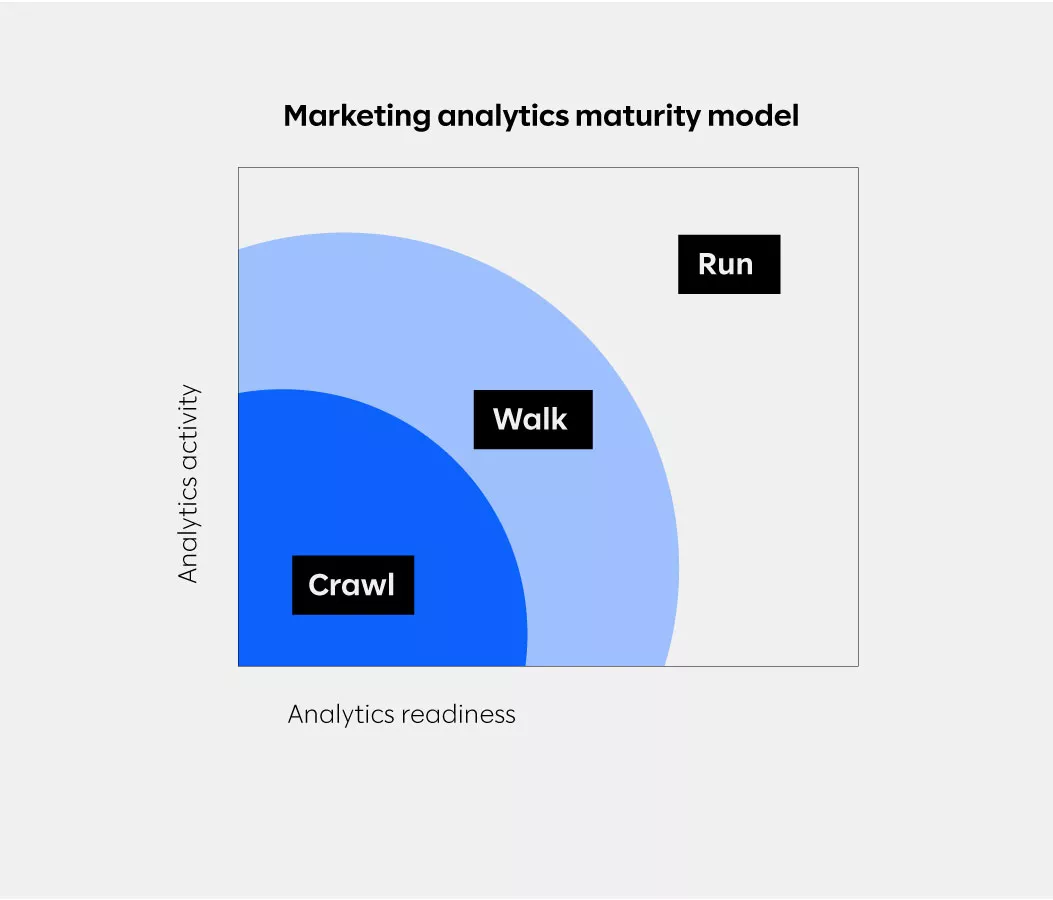Marketing without analytics: Like driving with your eyes closed

Why marketing analytics matters
Catchy, creative content should only be the beginning of your investment in marketing. Getting the most out of your marketing efforts means analytics. This is true regardless of your organization’s current level of analytic maturity. Organizations often invest heavily in marketing efforts on a spend-per-customer level without analytics to drive decision making. This is at best only doing half the job.
That’s the stick. Here's the carrot: The digital age is a gold mine of information for marketers. Indeed, marketing analytics has exploded—cookies, pixels, and customers’ near-constant online presence provides almost unimaginable data riches. But only if you know how to use it.
To best leverage these riches, you need the right analytical methods. Correct application of advanced data, statistical, and experimental analyses result in better returns on your investment, as measured in sales, customer retention, and lead generation.
With customers spending more time at home and more time on screens, digital advertising is now the primary route to customer eyeballs. And organizations have been heavily investing in the use of data and analytics to support marketing efforts, with over $24B spent annually. To justify these budgetary increases, marketing departments must show they are driving results.
Well-applied analytics methods are a marketing department’s strongest tool to make the most out of their investment and to drive improved return on ad spend—the bottom-line measure of campaign performance.
What can marketing analytics do for you?
Better analysis leads to better insights. Which leads to better decisions. Marketing analytics can answer the key questions that inform and support strategic marketing decisions:
Who are your profitable customers?
What types of ads should you be serving?
Where in the digital ecosystem are your ads best performing?
When are customers responsive?
How often do you need to address your customers?
Why should we invest in these marketing efforts, i.e., what’s your ROI?
Use analytics to answer all these questions and you’ll be a step ahead of your competitors.
Crawl/walk/run: What stage are you in?
Which use case your organization should tackle first depends on your organizational readiness to implement related solutions. The first step in any effort to improve your marketing analytics should be an accounting of where your organization stands, and what your next steps should be.
We like to think of the marketing analytics maturity model in terms of three stages: crawl, walk, and run. The good news is that no matter where you are, you can take advantage of best-in-class analytics immediately. But no single algorithm or technique will solve your problems. The winning formula will include a cross-team effort leveraging a variety of data sources and analytic approaches, all custom-fitted to your organization and industry.

Crawl
In the crawl phase of your marketing analytics journey, your focus should be on developing a data-driven understanding of your target audiences. This starts with integrating the data from the entire customer journey, from email/display/social media ad impressions to digital purchase completion. Marketing is a large-scale sales effort, and you need to understand your consumers and their behavior at every touch point.
A couple of things that are important at every stage, but particularly at the crawl stage:
Customer segmentation: Identify your customers’ demographics, socioeconomic segment, online searching patterns, purchase behavior, and geographic areas. Customize suitable marketing tactics for each segment.
A/B testing: A/B testing in this phase doesn’t necessarily require an investment in new technology, though that is definitely something you should consider down the line. It could be as simple as answering a question like, do users prefer our usual weekly email, or do they respond better to a new design? Split your recipient list in half, send one version to each, and voila! You are now an A/B tester. If you’ve never done it before, your first taste of A/B testing is incredibly empowering, not to mention fascinating. Plant the seeds now and become a completely data-driven organization in the future.
Walk
In this stage, you’re on your way, but still have work to do. You have marketing data in your own data lakes, and it’s available for campaign planning, experimentation, and analysis. Your next steps should include predictive analytics in campaign planning and machine learning for more targeted marketing. These two elements correspond to marketing mix modeling and recommendation engines, respectively.
Marketing mix modeling
To estimate the impact of various marketing mixes, you need to leverage statistical analysis—such as multivariate regressions—on sales and marketing data. This type of analysis should include geographic-based analyses, i.e., determining where your customers are and what types of media they use, with media mix strategies tailored accordingly. Example: you may find that your older customers are more likely to live in suburban/rural settings and rely on one set of media, while younger customers are more densely located in cities and use other media channels more heavily. Based on the location of these consumer subgroups, you may find better results by varying the media targets/spend by geographic location. This type of prescriptive analysis is most useful during the media campaign planning phase.
Recommendation engines
Recommended content: not just for Netflix anymore. Recommending lookalike content based on customers’ past behaviors—including purchases, clickstreams, website visits, transaction completions, cart abandons, etc.—is something most consumers now expect.
Next-best-offer algorithms are the 21st century personal shopper. During the walk stage, your organization is well positioned to take advantage of the plug-n-play recommendation engine tools available on the market—including those offered via third-party cloud service providers. These tools provide end-to-end solutions, allowing even teams with limited machine learning experience to take advantage of machine learning algorithms and generate data-driven recommendations (both content and products) for customers.
Run
Organizations in this phase should focus on the horizon, advancing ongoing analytics efforts and seeking to maximize the returns from campaigns and experimental marketing efforts. You can extend next-best-offer capabilities and algorithms, as well as further campaign experimentation efficacy with geo-lift experiments.
Recommendation engines: from off-the-shelf to tailored
If your business is already using an established plug-n-play type of recommendation engine, it’s worth considering a more customized solution. With the right team of data engineers and data scientists, the return on next-best-offer implementations can be maximized by developing such a customized recommendations engine. This all-in approach to developing a fully customized recommendations pipeline will leave no stone unturned in the quest to maximize the returns on next-best-offer marketing efforts.
Geo-lift experiments
Your organization may already conduct A/B tests. While A/B testing is good (and critical to marketing success), geo-lift experiments are better. One limitation of A/B experiments is the exogenous variations in user experiences. Some users will see more billboards/TV commercials for your products (or any other advertisements outside the campaign of interest), which can greatly impact the outcome of your head-to-head digital ad test.
Enter geo-lift experiments, where the control/treatment assignments are done by geographic regions. The core benefit of structuring marketing campaigns in such a setting is precisely to limit the exogenous (caused by outside forces) variations within your treatment/control groups. If all of a city/zip code/census DMA (designated market area) is assigned to either the treatment or the control group, then the TV ad/physical (billboard/bus/bus stop/etc.) ad exposure will more consistent within that group. This reduces the impact this exogenous variation can have on your campaign, as well as extending the application of any media mix modeling your organization is using.
This extension of the media mix modeling—and associated reduction in exogenous variation—establishes a counterfactual that leads to better estimates of the marginal gains of the treatment campaign over that of the control campaign. Time series regression should be used in concert with control regions to establish this counterfactual, i.e, what would have happened if treatment locations received the control campaign. This is all a long way of saying that it’s absolutely essential to answer one key question: Were more sales generated, or were they just shifted from one purchase channel to another?
Steps to success, before and after your campaign
Your organization should follow these mission-critical steps to enable marketing analytics efforts to pay dividends. On the front end of your campaign, there are two core steps that are necessary for success:
First, the objective of the campaign/experiment should be clearly defined and agreed upon by all relevant stakeholders up front. Little can derail the success of an analytics effort faster than post hoc arguments over the actual goal of the initiative.
Secondly, your organization needs to be appropriately invested in the effort, in terms of both time and resources, including devoting all the necessary data and technical know-how to the effort. This might sound obvious, but you’d be surprised at how many organizations expect success from half measures.
After your campaign, while conducting the analyses, there are several steps you should take on the back end take to achieve success.
From a statistical viewpoint, problems of attribution (omitted variable bias, which confounds variables) and collinearity (high correlation between variables and little variation in spend across channels) must be faced and solved.
From a data viewpoint, the amount of quality data on which to build predictive/prescriptive models can often be limited, and this must be accounted for.
From a strategic viewpoint, some companies have little variation in their marketing spend and campaigns, and thus have little historical insight into what variations in strategy may be more successful than others. Experimentation is therefore your third post-campaign step to success. This underscores the importance of A/B testing and other ways of measuring. If you don’t know what’s succeeding, how can you systematically get better?
Summary
Don’t underestimate the power of advanced analytics to make your marketing campaign a success. Analytics are crucial to both planning (via customer segmentation and media mix modeling) and evaluating your campaign. If your organization wants reliable and actionable insights into your marketing efforts, and confidence that you’re getting maximum ROI, there is simply no substitute for analytics. As in any journey, how can you get where you’re going if you don’t open your eyes?




